Blazing Arizona
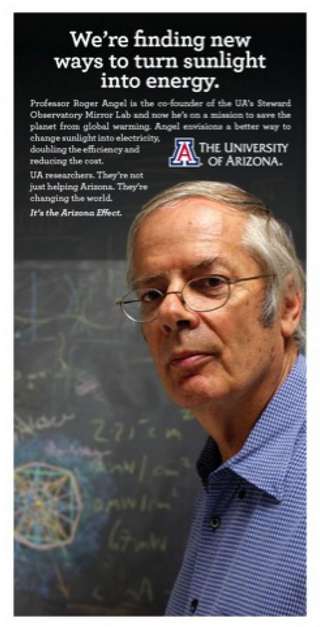 The last time I saw Roger Angel, he wasn't talking much about giant telescopes. Instead, the focus of the British-born astronomer was about how the telescope technologies he had spent a career perfecting might serve as a high-tech remedy for climate change and as a tool for power production.Angel's plan follows two paths. The first is ground-based. A large mirror tracks the sun directs the sun's light into a "power conversion unit" - a small box containing a sphere of glass which in turn focuses it even more. The concentrated sunlight, now more than a thousand times intense, hits a series of small high-efficiency photovoltaic cells. If scaled up, a square meter of solar cells could produce, Angel suggests, a kilowatt of usable power.
The last time I saw Roger Angel, he wasn't talking much about giant telescopes. Instead, the focus of the British-born astronomer was about how the telescope technologies he had spent a career perfecting might serve as a high-tech remedy for climate change and as a tool for power production.Angel's plan follows two paths. The first is ground-based. A large mirror tracks the sun directs the sun's light into a "power conversion unit" - a small box containing a sphere of glass which in turn focuses it even more. The concentrated sunlight, now more than a thousand times intense, hits a series of small high-efficiency photovoltaic cells. If scaled up, a square meter of solar cells could produce, Angel suggests, a kilowatt of usable power.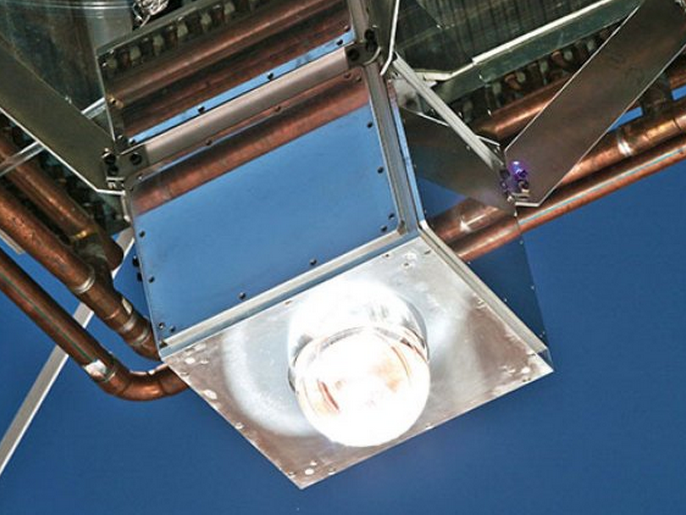 According to the web page of Angel's Tucson-based start-up called REhnu, the advantage of this design is that the large solar-collecting part of the system sends light to many cells contained in a small package, leading to greater efficiency. (This 2011 paper gives a more detailed description.) Build LOTS of these solar collectors/converters - maybe a square kilometer, maybe 20 times this - and you start getting power generation to rival that of a coal-fired plant.
According to the web page of Angel's Tucson-based start-up called REhnu, the advantage of this design is that the large solar-collecting part of the system sends light to many cells contained in a small package, leading to greater efficiency. (This 2011 paper gives a more detailed description.) Build LOTS of these solar collectors/converters - maybe a square kilometer, maybe 20 times this - and you start getting power generation to rival that of a coal-fired plant.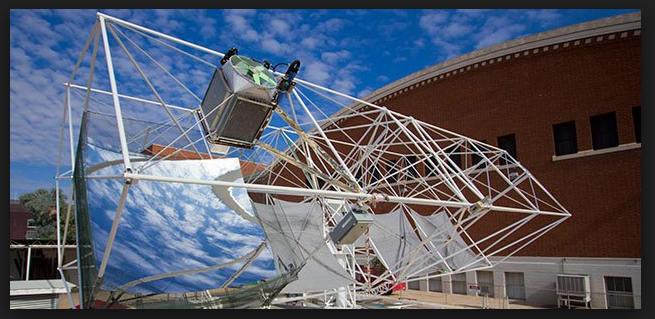 The second part of Angel's vision unfolds in space. A recent article by Lee Billings in Aeon offered an evocative view. A network of electromagnetic launchers - perhaps comparable to existing rail guns - would, using power from the ground-based solar mirror arrays, shoot a steady stream of packages out to one of the gravitationally stable points between the sun and earth. Each package would disperse some 800,000 ultra-thin glass disks, each about a half-meter in diameter. All together, these disks - trillions of them - would create a 100,000 kilometer wide sunlight diverting cloud. All together, this would divert enough energy - about 2% - from our planet so as to help regulate and lower the overall global temperature. It's a bold plan, to say the least. More on this shortly...Roger Angel has a track record of thinking ambitiously and building big. Year ago, I interviewed him for several hours while doing research for my book Giant Telescopes. From an early age he tinkered with electronics, fixed radios, and built gadgets like a primitive acoustical radar. Degrees from Oxford followed. Starting in the late 1970s, Angel, working with a few colleagues at the University of Arizona, began to reconceptualize the manufacture of really big mirrors for ground-based telescopes. Recall that at this time, the largest telescope mirror was the 200-inch disk in the Hale Telescope on Palomar Mountain. Some in the science community thought this was the size limit of traditional telescope mirrors.Angel's innovation was recognizing that molten glass, when spun rapidly, forms a parabola. And a parabola is the optimal starting shape for a telescope mirror. Experiments with a homemade furnace and Pyrex custard cups led to the eventual creation of giant rotating furnace built underneath the university's football stadium.
The second part of Angel's vision unfolds in space. A recent article by Lee Billings in Aeon offered an evocative view. A network of electromagnetic launchers - perhaps comparable to existing rail guns - would, using power from the ground-based solar mirror arrays, shoot a steady stream of packages out to one of the gravitationally stable points between the sun and earth. Each package would disperse some 800,000 ultra-thin glass disks, each about a half-meter in diameter. All together, these disks - trillions of them - would create a 100,000 kilometer wide sunlight diverting cloud. All together, this would divert enough energy - about 2% - from our planet so as to help regulate and lower the overall global temperature. It's a bold plan, to say the least. More on this shortly...Roger Angel has a track record of thinking ambitiously and building big. Year ago, I interviewed him for several hours while doing research for my book Giant Telescopes. From an early age he tinkered with electronics, fixed radios, and built gadgets like a primitive acoustical radar. Degrees from Oxford followed. Starting in the late 1970s, Angel, working with a few colleagues at the University of Arizona, began to reconceptualize the manufacture of really big mirrors for ground-based telescopes. Recall that at this time, the largest telescope mirror was the 200-inch disk in the Hale Telescope on Palomar Mountain. Some in the science community thought this was the size limit of traditional telescope mirrors.Angel's innovation was recognizing that molten glass, when spun rapidly, forms a parabola. And a parabola is the optimal starting shape for a telescope mirror. Experiments with a homemade furnace and Pyrex custard cups led to the eventual creation of giant rotating furnace built underneath the university's football stadium.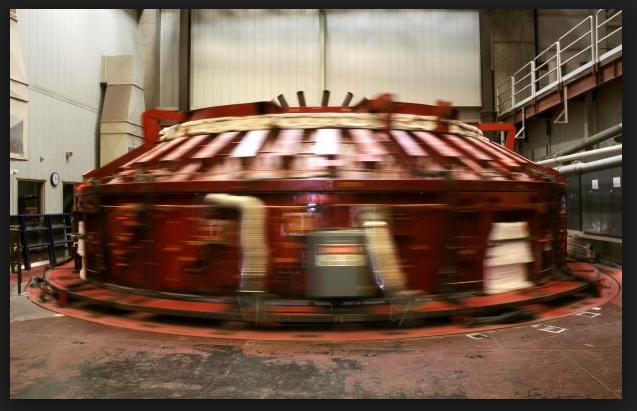 As the temperature slowly rose, the furnace would begin to rotate. The glass inside would gradually soften and flow through the carefully-spaced gaps around the solid ceramic cores while a smooth surface of glass formed on top of them. After cooling and washing, what was left would be a glass mirror blank with a roughly parabolic surface and mostly hollow honeycombed interior - large AND lightweight, in other words. Giant mirrors manufactured using processes Angel and his colleagues pioneered now sit at the heart of telescopes on mountaintops in New Mexico, Arizona, and Chile.
As the temperature slowly rose, the furnace would begin to rotate. The glass inside would gradually soften and flow through the carefully-spaced gaps around the solid ceramic cores while a smooth surface of glass formed on top of them. After cooling and washing, what was left would be a glass mirror blank with a roughly parabolic surface and mostly hollow honeycombed interior - large AND lightweight, in other words. Giant mirrors manufactured using processes Angel and his colleagues pioneered now sit at the heart of telescopes on mountaintops in New Mexico, Arizona, and Chile.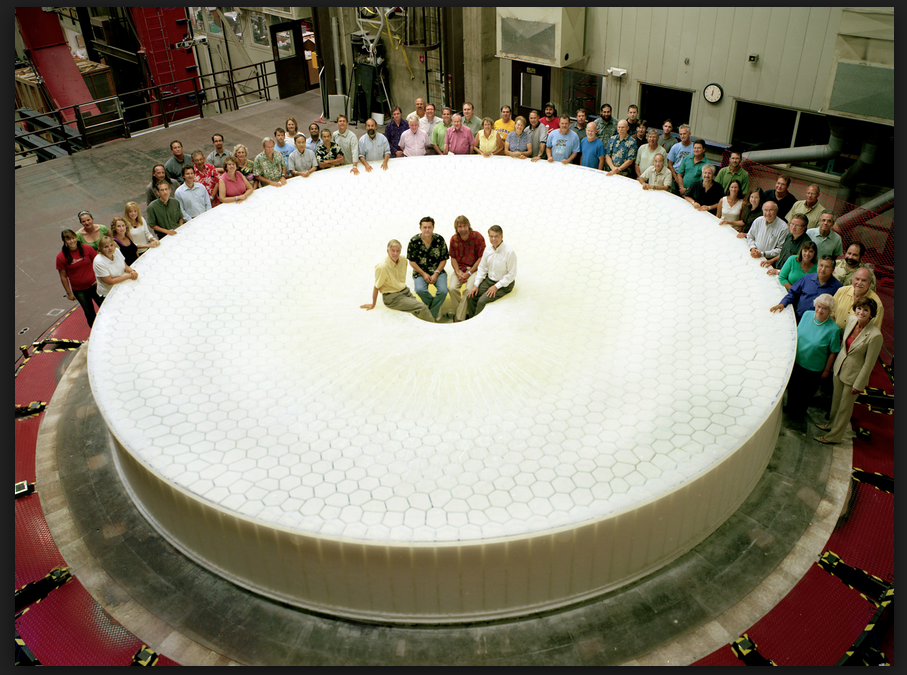 Fast forward to 2014 and Angel's plans to turn telescope technology to solar power. There is a fantastic precedent running parallel to Angel's visionary plan that fascinates me. Roger Angel is not the only Arizona-based scientist and instrument builder to imagine that astronomical technology could also be applied to energy production.In the early 1970s, Aden Meinel proposed something similar.Meinel was an optical engineer and the first director of the Kitt Peak National Observatory. During the Cold War, he also contributed optical designs to classified U.S. reconnaissance platforms. But, as anxiety about U.S. energy dependence as well as fuel prices spiked, Meinel and his wife Marjorie - also an astronomer - turned their attention to solar power.
Fast forward to 2014 and Angel's plans to turn telescope technology to solar power. There is a fantastic precedent running parallel to Angel's visionary plan that fascinates me. Roger Angel is not the only Arizona-based scientist and instrument builder to imagine that astronomical technology could also be applied to energy production.In the early 1970s, Aden Meinel proposed something similar.Meinel was an optical engineer and the first director of the Kitt Peak National Observatory. During the Cold War, he also contributed optical designs to classified U.S. reconnaissance platforms. But, as anxiety about U.S. energy dependence as well as fuel prices spiked, Meinel and his wife Marjorie - also an astronomer - turned their attention to solar power.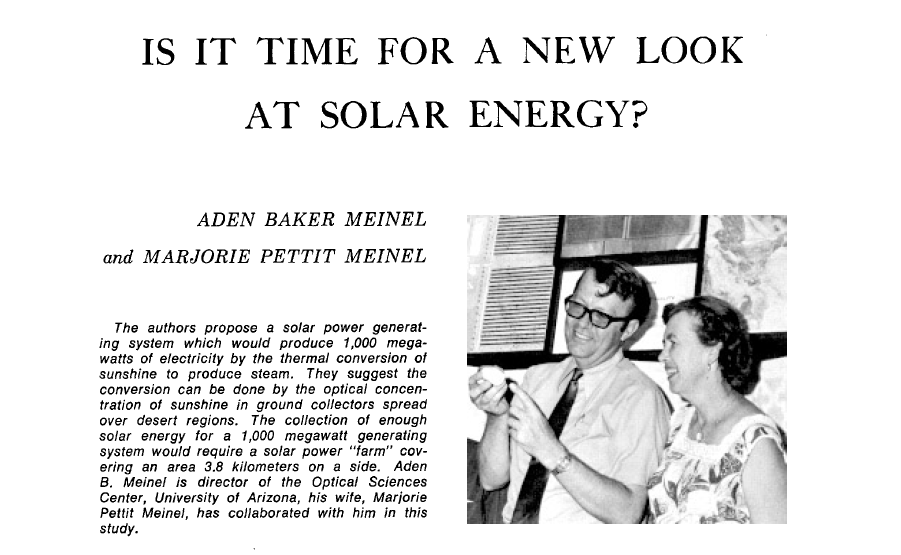 In papers published in journals like Physics Today, the Meinels proposed a massive power-generating system akin to the dams of the Tennessee Valley Authority.
In papers published in journals like Physics Today, the Meinels proposed a massive power-generating system akin to the dams of the Tennessee Valley Authority.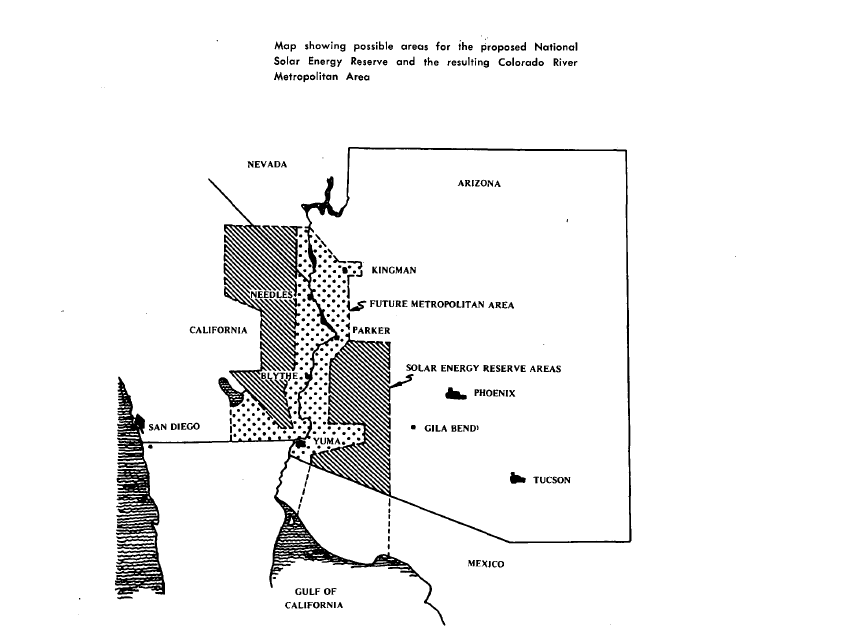 The Meinels described a future "National Solar Energy Reserve" on the border between California and Arizona. These "prime lands for solar harvest" would cover 5000 square miles. Vast fields of solar collectors would generate electricity that could then be distributed throughout the Southwest. Cars once powered by gasoline would be converted to electricity, alleviating air pollution. Cities would bloom in the desert. The Meinels' vision was far, far beyond anything readers of The Whole Earth Catalog or E.F. Schumacher's Small is Beautiful might have imagined.
The Meinels described a future "National Solar Energy Reserve" on the border between California and Arizona. These "prime lands for solar harvest" would cover 5000 square miles. Vast fields of solar collectors would generate electricity that could then be distributed throughout the Southwest. Cars once powered by gasoline would be converted to electricity, alleviating air pollution. Cities would bloom in the desert. The Meinels' vision was far, far beyond anything readers of The Whole Earth Catalog or E.F. Schumacher's Small is Beautiful might have imagined. To any of the countercultures' communalists who encountered the Meinels' ideas, the reaction must have been schizophrenic. On one hand, here was an ostensibly environmentally friendly soft technology. It used solar power to address smog and resource depletion. On the other hand, the manner in which it would be carried out could only be top-down, centralized, and run as a massive mega-project. Instead of encouraging a back-to-the-land ethos, it would instead encourage more urban development and concentration of power in the hands of the Establishment.The Meinels' scheme was not out of line with other technocratic visions of the Apollo era. If you see similarities between their tech-heavy approach and physicist Gerard O'Neill's ideas for space settlements as a way of reducing human impact on the planet, you're right. The parallels between O'Neill and Roger Angel are also quite striking - high-flying physicist does a career shift to consider how the technologies he has helped develop might be used in futuristic schemes. O'Neill, like Angel now, also envisioned an electromagnetic launcher as a key component in a much grander system. Finally, the reaction of environmentalists to grand geoengineering ideas like Angel's are much the same as 1970s era counterculturalists' response to O'Neill's visioneering for space colonies.
To any of the countercultures' communalists who encountered the Meinels' ideas, the reaction must have been schizophrenic. On one hand, here was an ostensibly environmentally friendly soft technology. It used solar power to address smog and resource depletion. On the other hand, the manner in which it would be carried out could only be top-down, centralized, and run as a massive mega-project. Instead of encouraging a back-to-the-land ethos, it would instead encourage more urban development and concentration of power in the hands of the Establishment.The Meinels' scheme was not out of line with other technocratic visions of the Apollo era. If you see similarities between their tech-heavy approach and physicist Gerard O'Neill's ideas for space settlements as a way of reducing human impact on the planet, you're right. The parallels between O'Neill and Roger Angel are also quite striking - high-flying physicist does a career shift to consider how the technologies he has helped develop might be used in futuristic schemes. O'Neill, like Angel now, also envisioned an electromagnetic launcher as a key component in a much grander system. Finally, the reaction of environmentalists to grand geoengineering ideas like Angel's are much the same as 1970s era counterculturalists' response to O'Neill's visioneering for space colonies.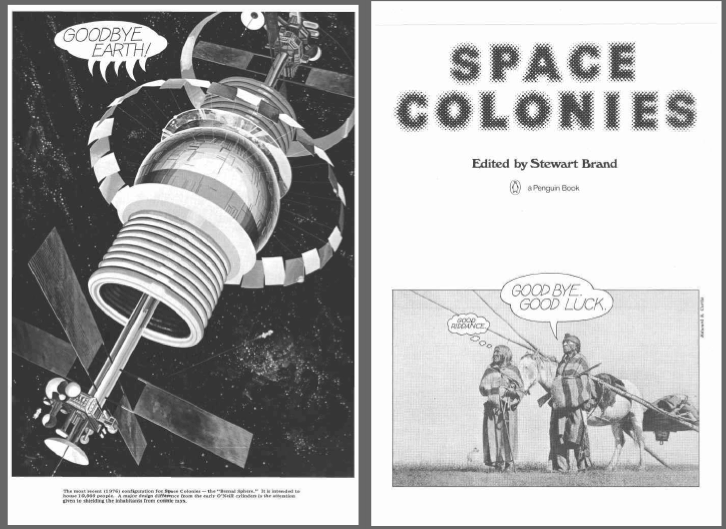 The Meinels described their vision as "a great goal that reaches to the limits of creative imagination." This statement reflects the essence of the visioneering ethos that I describe in my recent book. The Meinels' ideas - like those of Roger Angel's today - push at the boundaries of what might be technically possible. They propose a radically different future in which massive resource intensive technological solutions - Angel estimates his space-based solar shield might cost $5 trillion - are presented as escapes from what are fundamentally social, political, and economic problems. More than anything, visioneering ideas can help foster dialogue about the future.Do I think Angel's vision of the (solar-powered) technological future will come to pass. Not really. But can it prompt debate about the limits of technology as a means to address climate change and other pressing planetary problems? Yes. Is this a good thing? Yes - so long as his and other visioneering schemes serve as a catalyst, not distraction.
The Meinels described their vision as "a great goal that reaches to the limits of creative imagination." This statement reflects the essence of the visioneering ethos that I describe in my recent book. The Meinels' ideas - like those of Roger Angel's today - push at the boundaries of what might be technically possible. They propose a radically different future in which massive resource intensive technological solutions - Angel estimates his space-based solar shield might cost $5 trillion - are presented as escapes from what are fundamentally social, political, and economic problems. More than anything, visioneering ideas can help foster dialogue about the future.Do I think Angel's vision of the (solar-powered) technological future will come to pass. Not really. But can it prompt debate about the limits of technology as a means to address climate change and other pressing planetary problems? Yes. Is this a good thing? Yes - so long as his and other visioneering schemes serve as a catalyst, not distraction.